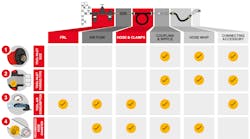Tech Tip: Four key factors to ensure optimal performance of your pneumatic tool
Have you found that your pneumatic tool is underpowered or not running as expected? Well, it could all come down to your airline accessories and/or connection, rather than the tool itself. It’s worth quickly checking your airline installation – a simple job that only takes a couple of minutes.
It’s easy: each accessory from the filter, regulator, and lubricator (FRL) to the tool’s inlet should be selected considering the following four key tool values:
1. Inlet size
= size of the tool’s air inlet. This value will help you select the correct size of connector.
2. Inlet type
= type of thread on the tool air inlet. The three main types of pneumatic tool inlet threads are:
- NPT (National Pipe Thread), mostly used in America,
- PT (Pipe Thread), mostly used in Asia,
- BSP (British Standard Pipe), mostly used in Europe.
Safety tip: To avoid any wrong connections or air leakage, never mix thread types.
3. Air compression as dynamic pressure
= the volume of compressed air required by the tool to work properly and efficiently. This value is given in cubic feet per meter (cfm) or in liters per second/minute (l/s or l/m).
4. Recommended hose diameter
= while this isn’t typically classified as a tool value, tool manufacturers usually recommend the correct hose diameter to help ensure your tools perform at their best. The value is specified in millimeters (mm) and/or in inch (“).
Where to find the information?
Refer to the manufacturer’s recommendations online, to the tool print catalog, or the operating manual.
By double-checking these four values, you will not only increase your tool’s efficiency but also reduce safety hazards in the workplace linked to airline installation failure.
Information provided by Chicago Pneumatic
